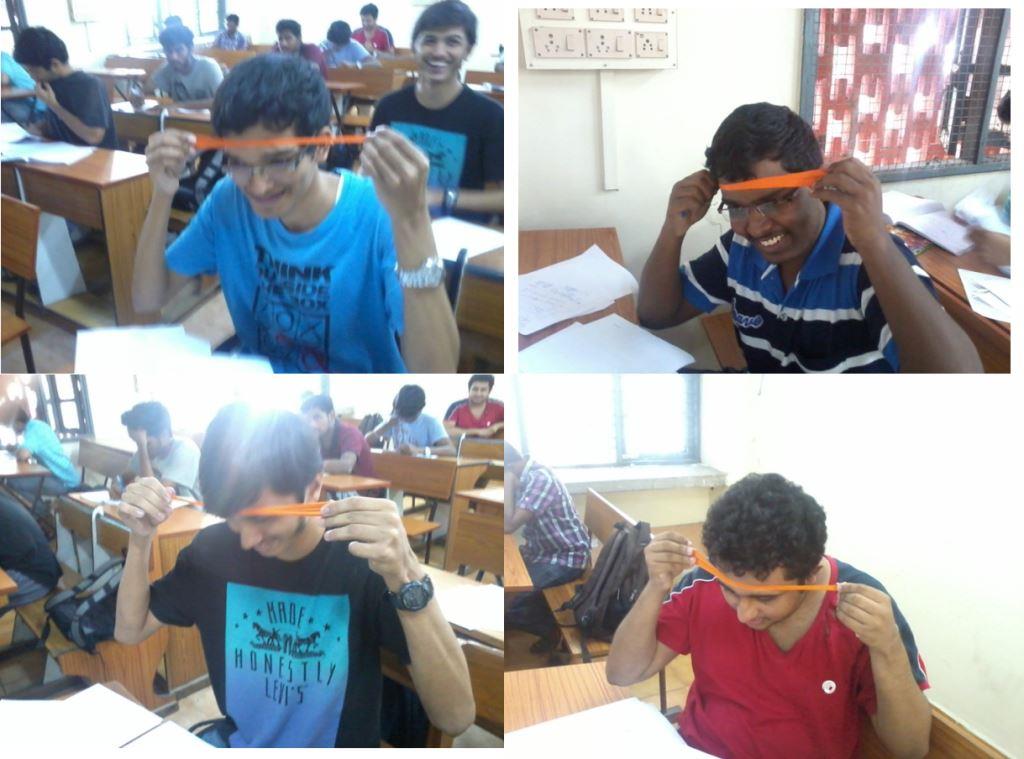Over the past decade, I have also taught a broad spectrum of theory courses at IIT Madras – to list them as complementing pairs: ‘classical’ and ‘quantum’ physics; ‘mathematical’ physics and ‘experimental’ physics, ‘hard’ and ‘soft’ condensed matter physics. The complete list is given below.
PHYSICS (EXAMS) CAN BE FUN: These pictures describe some joyful moments from the Final Exam of Classical Physics PH3500 (minor) theory course held on 27th November 2015. The students were required to solve the statistical mechanics problem of a stretched rubber-band. They started with the random-walk problem of an ideal polymer chain with N-monomer units and all possible bond angles. From the number of allowed configurations for any given end-to-end distance of the polymer chain, they found the entropy as a function of polymer length S(L). Stretching a polymer chain led to a Hookean restoring force f(L) of purely entropic origin, while the bond distances remained unchanged. In familiar solid objects, such as metal wires, the tension under stretched conditions arises due to attractive forces between atoms that make up the wire. In the case of a polymer, the same originates from the tension due to entropy of the chain! The students next computed the quantity (∂T/∂L)s for the system to show that a stretched rubber-band undergoes a change in temperature. They finally placed a stretched balloon on their foreheads with the skin serving as the thermometer, to verify their calculations!!

PS - This is an experiment that is easy to do. Stretch a balloon or a rubber-band and place it on your forehead. Relax it as quickly as possible to the original length and immediately place it again on your forehead. Examine the change in temperature sensed by your skin.
Strange flips of the Tennis Racket!
| Sl. No. | Course No | Course Title |
|---|---|---|
| 1 | PH 3520 | Quantum Physics (minor) |
| 2 | PH 3500 | Classical Physics (minor) |
| 3 | EP 2102 | Elements of Classical Dynamics |
| 4 | EP 2110 | Introduction to Mathematical Physics |
| 5 | PH 1010 | First Year Physics-1 (also as coordinator) |
| 5 | PH 1020 | First Year Physics-2 |
| 6 | EP 3220 | Solid State Physics |
| Sl. No. | Course No | Course Title |
|---|---|---|
| 1 | PH 5810 | Introduction to Soft Matter Physics (elective) |
| 2 | PH 5110 | Science and Technology of the Solid State |
| 3 | PH 5050 | Mathematical Physics-II |
| 4 | PH 7090 | Foundations of Experimental Physics (also as coordinator) |
| 5 | PH 5060 | MSc. Lab-1 (also as coordinator) |
| 5 | PH 5120 | MSc. Lab-2 (also as coordinator) |
| 6 | PH 5330 | M.Tech. Lab. |
| 7 | PH 5350 | M.Tech. Lab. |